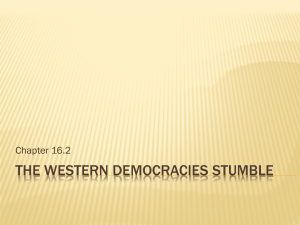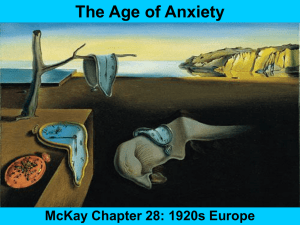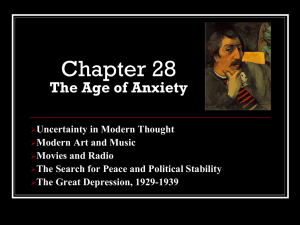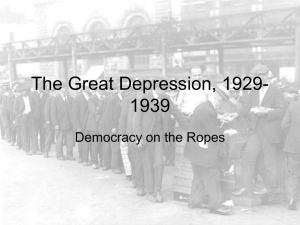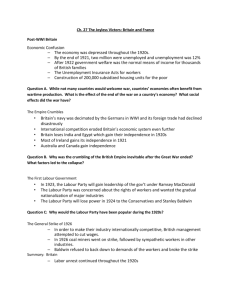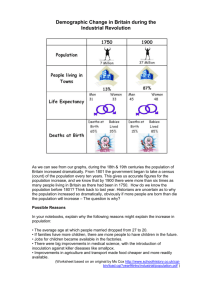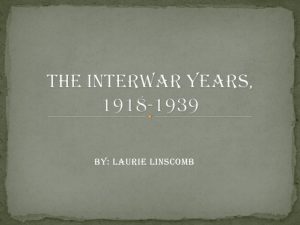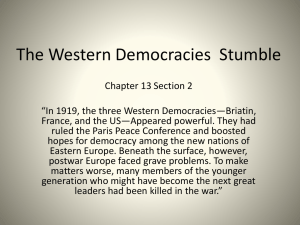The Age of Anxiety
advertisement
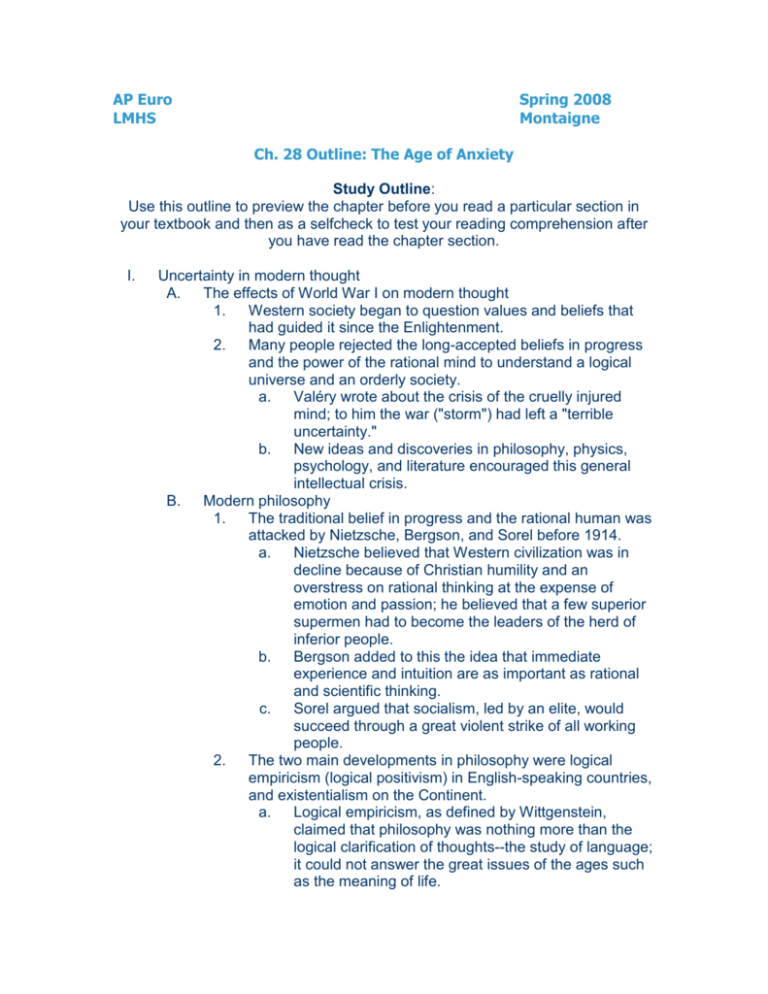
AP Euro LMHS Spring 2008 Montaigne Ch. 28 Outline: The Age of Anxiety Study Outline: Use this outline to preview the chapter before you read a particular section in your textbook and then as a selfcheck to test your reading comprehension after you have read the chapter section. I. Uncertainty in modern thought A. The effects of World War I on modern thought 1. Western society began to question values and beliefs that had guided it since the Enlightenment. 2. Many people rejected the long-accepted beliefs in progress and the power of the rational mind to understand a logical universe and an orderly society. a. Valéry wrote about the crisis of the cruelly injured mind; to him the war ("storm") had left a "terrible uncertainty." b. New ideas and discoveries in philosophy, physics, psychology, and literature encouraged this general intellectual crisis. B. Modern philosophy 1. The traditional belief in progress and the rational human was attacked by Nietzsche, Bergson, and Sorel before 1914. a. Nietzsche believed that Western civilization was in decline because of Christian humility and an overstress on rational thinking at the expense of emotion and passion; he believed that a few superior supermen had to become the leaders of the herd of inferior people. b. Bergson added to this the idea that immediate experience and intuition are as important as rational and scientific thinking. c. Sorel argued that socialism, led by an elite, would succeed through a great violent strike of all working people. 2. The two main developments in philosophy were logical empiricism (logical positivism) in English-speaking countries, and existentialism on the Continent. a. Logical empiricism, as defined by Wittgenstein, claimed that philosophy was nothing more than the logical clarification of thoughts--the study of language; it could not answer the great issues of the ages such as the meaning of life. b. C. D. Existentialism, first developed in Germany by Heidegger and Jaspers, and then by Sartre and Camus in France, stressed that humans can overcome the meaninglessness of life by individual action. c. Existentialism was popular in France after the Second World War because it advocated positive human action at a time of hopelessness. The revival of Christianity 1. Before 1914, Protestant theologians, such as Schweitzer, stressed the human nature of Jesus and turned away from the supernatural aspects of his divinity; they sought to harmonize religious belief with scientific findings. 2. A revitalization of fundamental Christianity took place after World War I. a. Kierkegaard was rediscovered; he had criticized the worldliness of the church and stressed commitment to a remote and majestic God. b. Barth stressed the imperfect and sinful nature of man and the need to accept God's truth through trust, not reason. c. Catholic existential theologians, such as Marcel, found new hope in religion by emphasizing the need for its hope and piety in a broken world. The new physics 1. Prior to the 1920s, science was one of the main supports of Western society's optimistic and rational worldview. 2. The challenge to Newtonian physics by scientists such as Planck and Einstein undermined belief in constant natural laws. a. Plank's work with subatomic energy showed that atoms were not the basic building blocks of nature. b. Einstein postulated that time and space are relative, the universe is infinite, and matter and energy are interchangeable. 3. The 1920s were the "heroic age of physics." a. Rutherford split the atom. b. Subatomic particles were identified, notably the neutron. c. The new physics described a universe that lacked absolute objective reality; Heisenberg claimed that instead of Newton's rational laws, there are only tendencies and probabilities. d. In short, science seemed to have little to do with human experience and human problems. E. II. Freudian psychology 1. Prior to Freud, it was assumed that the conscious mind processed experiences in a rational and logical way. 2. According to Freud, human behavior is basically irrational. a. The key to understanding the mind is the irrational unconscious (the id), which is driven by sexual, aggressive, and pleasure-seeking desires. b. Behavior is a compromise between the needs of the id and the rationalizing conscious (the ego), which mediates what a person can do, and ingrained moral values (the superego), which tell what a person should do. 3. Instinctual drives can easily overwhelm the control mechanisms; yet rational thinking and traditional moral values can cripple people with guilt and neuroses. 4. Many interpreted Freudian thought as an encouragement of an uninhibited sex life. F. Twentieth Century literature 1. The postwar moods of pessimism, relativism, and alienation influenced novelists. 2. Literature focused on the complexity and irrationality of the human mind. 3. Writers such as Proust embraced psychological relativity-the attempt to understand oneself by looking at one's past. 4. Novelists such as Woolf, Faulkner, and Joyce adopted the stream of consciousness technique, in which ideas and emotions from different time periods bubble up randomly. 5. Some literature, such as that of Spengler, Kafka, and Orwell, was anti-utopian--it predicted a future of doom. Modern art and music A. "Modernism" in art and music meant constant experimentation and a search for new forms of expression. B. Architecture and design 1. The new idea of functionalism in architecture, exemplified by Le Corbusier, emphasized efficiency and clean lines instead of ornamentation. 2. The Chicago school of architects, led by Sullivan, pioneered in the building of skyscrapers. 3. Frank Lloyd Wright designed truly modern houses featuring low lines, open interiors, and mass-produced building materials. 4. Germany was the leader in modern architecture. a. The Bauhaus school under Gropius became the major proponent of functional and industrial forms. b. III. It combined the study of fine art with the study of applied art. c. The Bauhaus stressed good design for everyday life. 5. Van der Rohe brought European functionalism to Chicago-and hence steel frame and glass wall architecture. C. Modern painting 1. French impressionism yielded to nonrepresentational expressionism, which sought to portray the worlds of emotion and imagination, as in the works of van Gogh, Gauguin, Cézanne, and Matisse. 2. Cubism, founded by Picasso, concentrated on zigzagging lines and overlapping planes. 3. Nonrepresentational art turned away from nature completely; it focused on mood, not objects. 4. Dadaism and surrealism became prominent in the 1920s and 1930s. a. Dadaism delighted in outrageous conduct. b. Surrealists, inspired by Freud, painted wild dreams and complex symbols. D. Modern music 1. The concept of expressionism also affected music, as in the work of Stravinsky and Berg. 2. Some composers, led by Schönberg, abandoned traditional harmony and tonality. Movies and radio A. The general public embraced movies and radio enthusiastically. B. The movie factories and stars such as Mary Pickford, Lillian Gish, Douglas Fairbanks, Rudolph Valentino, and Charlie Chaplin created a new medium and a new culture. C. Moviegoing became a form of escapism and the main entertainment of the masses. D. Radio, which became possible with Marconi's "wireless" communication and the development of the vacuum tube, permitted transmission of speech and music, but major broadcasting did not begin until 1920. 1. Then every country established national broadcasting networks; by the late 1930s, three of four households in Britain and Germany had a radio. 2. Dictators and presidents used the radio for political propaganda. E. Movies also became tools of indoctrination. 1. Eisenstein used film to dramatize the communist view of Russian history. 2. In Germany, Riefenstahl created a propaganda film for Hitler. IV. The search for peace and political stability A. The search for peace was difficult: Germany hated the Treaty of Versailles, France was fearful and isolated, Britain was undependable, and the United States was not interested. Besides, Eastern Europe was in ferment and the international economy was disrupted and poor. B. Yet, from 1925 to late 1929, it appeared that peace and stability were within reach. But the collapse of the 1930s ended that quest. C. Germany and the Western powers 1. Germany was the key to lasting peace, and the Germans hated the Treaty of Versailles. 2. France believed that an economically weak Germany was necessary for its security and wanted massive reparations to repair devastated northern France. 3. Britain needed a prosperous Germany in order to maintain the British economy. a. J. M. Keynes, an economist, argued that the Versailles treaty crippled the European economy and needed revision. b. His attack on the treaty contributed to guilt feelings about Germany in Britain. c. As a result, France and Britain drifted apart. 4. When Germany refused to continue its heavy reparations payments, French and Belgian armies occupied the Ruhr (1923). 5. The Germans stopped work in the factories, and France occupied the German Rhineland; this left many Germans unemployed. a. Inflation skyrocketed; prices soared and savings were wiped out. b. Resentment and political unrest among the Germans grew; many blamed the Western governments, and some blamed the Jews and communists. 6. Under Stresemann, Germany agreed to revised reparations payments, and France agreed to re-examine Germany's ability to pay. a. Stresemann represented a new compromising mood in both Germany and France. D. Hope in foreign affairs (1924-1929) 1. The Dawes Plan (1924) provided a solution to the reparations problem: the United States lent money to Germany so it could pay France and Britain so they could pay the United States. 2. V. In 1929, the Young Plan further reduced German reparations. 3. The treaties of Locarno (1925) eased European disputes. a. Germany and France accepted their common border. b. Britain and Italy agreed to fight either France or Germany if either country invaded the other. 4. Germany joined the League of Nations in 1926. 5. The Kellogg- Briand Pact (1928) condemned war, and the signing states agreed to settle international disputes peacefully. E. Hope in democratic government 1. The Ruhr crisis saw the emergence of the radical right under Hitler; his beer hall plot failed, but he set out his theories in Mein Kampf. 2. But after 1923, democracy took root in Germany as the economy boomed. 3. However, there were sharp political divisions in the country. a. The right consisted of nationalists and monarchists. b. The communists remained active on the left. c. Most working class people supported the socialist Social Democrats. 4. In France, the democratically elected government rested in the hands of the middle class-oriented moderates, while communists and socialists battled for the support of the workers. 5. Northern France was rebuilt, and Paris became the world's cultural center. 6. Britain's major problem was unemployment, and the government's efforts to ease it led the country gradually toward state-sponsored welfare plans. a. Britain's Labour party, committed to revisionist socialism, replaced the Liberals as the main opposition party to the Conservatives. b. Labour, under MacDonald, won in 1924 and 1929, yet moved toward socialism gradually. The Great Depression (1929-1939) A. The depression of 1929-1939 was worldwide and long lasting--and it caused many to turn to radical solutions. B. The economic crisis 1. The depression began with the American stock market crash (October 1929). a. Net investment in factories and farms fell while share prices soared. b. Many investors and speculators had bought stocks on margin (paying only a small part of the purchase price and borrowing the rest from their stockbrokers). c. C. D. E. When prices started to fall, thousands of people had to sell their shares at once to pay their brokers, and a financial panic started. 2. Financial crisis led to a decline in production, first in the United States and then in Europe, and an unwise turn to protective tariffs. 3. The absence of international leadership and poor national economic policies added to the depression. Mass unemployment 1. As production decreased, workers lost their jobs and had no money to buy goods, which cut production even more. 2. Mass unemployment also caused great social and psychological problems. The New Deal in the United States 1. Roosevelt's goal was to reform capitalism--especially by giving aid to farmers by raising agricultural prices and restricting production (via Agricultural Adjustment Act of 1933). 2. Government intervention and regulation took place through the National Recovery Administration (NRA)--designed to reduce competition, fix prices and wages. 3. The NRA was declared unconstitutional (1935), and Roosevelt decided to attacked the problem of mass unemployment by government employment of as many people as possible. a. The popular Work Projects Administration (1935) employed millions of people. b. Other social measures, such as social security and government support for labor unions, also eased the hardships of the depression. 4. Although the New Deal helped, it failed to pull the United States out of the depression. a. Some believe Roosevelt should have nationalized industry so that national economic planning could have worked. b. Many economists argued that the New Deal did not put enough money into the economy through deficit financing. The Scandinavian response to depression 1. Backed by a strong tradition of community cooperation, socialist parties were firmly established in Sweden and Norway by the 1920s. 2. Deficit spending to finance public works and create jobs was used to check unemployment and revive the economy after 1929. 3. F. Scandinavia's welfare socialism, though it depended on a large bureaucracy and high taxes, offered an appealing middle way between capitalism and communism or fascism in the 1930s. Recovery and reform in Britain and France 1. Britain's concentration on its national market aided its economic recovery--so that by 1937 production had grown by 20 percent. 2. Government instability in France prevented recovery and needed reform. a. The Socialists, led by Blum, became the strongest party in France, and his Popular Front government attempted New Deal-type reforms. b. France was drawn to the brink of civil war, and Blum was forced to resign (1937), leaving the country to drift aimlessly.
